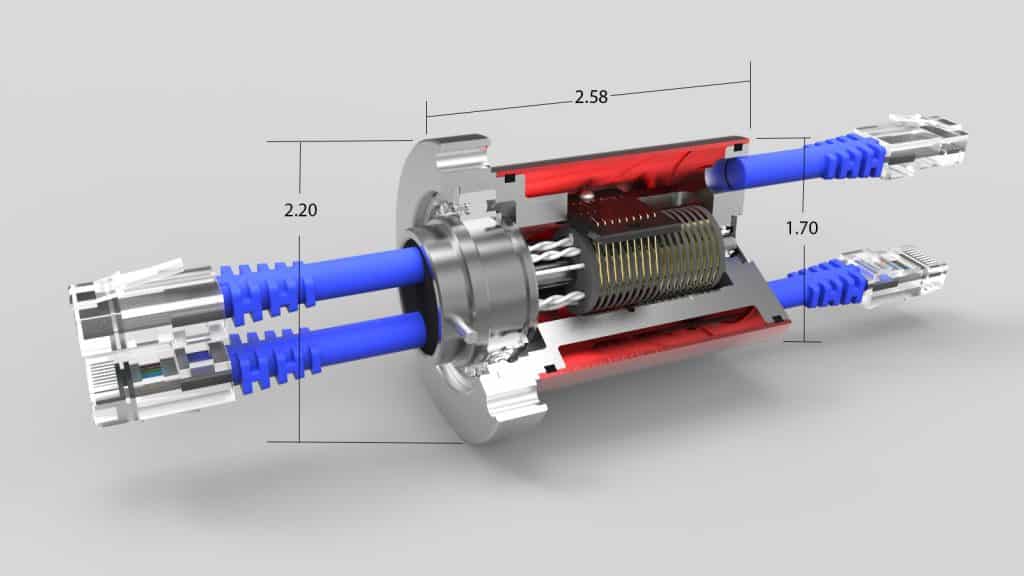Video surveillance systems play a crucial role in maintaining security and monitoring activities in various environments, such as commercial buildings, public spaces, and industrial facilities. Ethernet slip ring have emerged as a vital component in these systems, enabling the seamless transmission of video signals and data between stationary control centers and rotating cameras.
Before studying how Ethernet slip rings work in video surveillance systems, we need to understand slip ring and Ethernet slip ring.
What is an Ethernet Slip Ring?
Slip rings play a vital role in enabling the transmission of electrical signals and power between rotating interfaces. However, as technology has improved, there has been a need to transmit data at higher speeds and with greater bandwidth. This has led to the development of Ethernet slip rings, which combine the benefits of slip rings with the functionality of the Ethernet protocol.
Traditional slip rings have been widely used in various industries for many years. They are particularly suitable for applications requiring continuous rotation, such as wind turbines, cranes, robotics and monitoring systems. However, as the demand for high-speed data transmission grows, the limitations of traditional slip rings become apparent. Standard slip rings are not designed to meet the complex requirements of modern data-intensive systems, leading to problems such as signal attenuation, interference and limited bandwidth. To bridge this gap, Ethernet slip rings have been developed to provide reliable and high-speed data transmission solutions. Ethernet slip rings combine the advantages of slip rings with the functionality of the widely used Ethernet protocol for networking and data communications. These advanced slip rings incorporate Ethernet channels in their design, allowing data to be transferred at faster speeds and with higher bandwidth.
Feature
◆ Multi-point brush contact material ensures long life
◆ Stable transmit 1~2 channels Gigabit Ethernet signal
◆ Integrated structure design for easy installation
◆ Standard model and customization are available
◆ IP 51 (IP54-IP68 can be customized)
◆ With RJ45 male connectors, RJ45 female optional
◆ Ethernet cable connection
◆ With advantages of reliable transmitting, no packet loss, no string code, low return loss, low insertion loss, etc.
◆ Free maintenance
Option
◆ Optional for underwater IP65, IP68Operation speed, current &voltage
◆ No. of rings
◆ Connector
◆ Housing material
◆ Position of wire outlet, wire length
◆ Protection level (dust and water)
◆ Flange mounting is optional
◆ Operating temperature
◆ Support mixed high speed data transmission(including Ethernet, USB, Profibus, Ethernet, CANOPEN, CANBUS, RS232, RS485, etc.)
◆ Fluidic rotary joints, FORJ, and electric slip rings can be mixed
Why is Ethernet Slip Ring the Choice of Video Surveillance System? What are the advantages?
Ethernet slip rings offer several advantages when integrated into a video surveillance system.
First, they offer faster data rates, typically between 10 Mbps and 10 Gbps, depending on the model. This increased speed facilitates real-time data transfer and enables seamless communication between the rotating and stationary components of the system. Slip rings support high-speed data transmission, which is critical for transmitting high-resolution video signals. They transmit an uncompressed video signal, ensuring clarity and detail in captured footage. This is especially important in applications where image quality is critical, such as facial recognition, license plate recognition, and object tracking.
Second, Ethernet slip rings offer greater bandwidth capacity, allowing large amounts of data to be transmitted simultaneously. This makes them ideal for applications involving high-resolution video streaming, data-intensive sensors, and other bandwidth-hungry tasks.
Plus, they ensure uninterrupted video transmission, even during PTZ (PTZ-Zoom) camera rotation. This allows continuous monitoring of wide areas without loss of video quality or data.
Ethernet slip rings also help increase the scalability and flexibility of video surveillance systems. With the ability to transmit data over long distances, they facilitate the installation of cameras in remote or challenging locations. This flexibility enables comprehensive coverage and monitoring of large areas, improving the overall effectiveness of the surveillance system.
Another notable feature of Ethernet slip rings is their compatibility with standard Ethernet protocols. This compatibility allows easy integration into existing networks and ensures seamless communication with other Ethernet-enabled devices.
In addition, Ethernet slip rings support Power over Ethernet (PoE) technology, allowing power and data to be transmitted over a single Ethernet cable. This eliminates the need for a separate power cord for the swivel camera, simplifying installation and reducing cable clutter. It also enables centralized power management and remote control of cameras.
In terms of maintenance, Ethernet slip rings require minimal maintenance, ensuring reliable and long-lasting operation. They are designed to withstand environmental factors such as temperature changes, humidity and vibration, making them suitable for indoor and outdoor video surveillance applications.
In summary, Ethernet slip rings have become an important component in video surveillance systems for uninterrupted video transmission, high-speed data transmission, scalability and flexibility. By integrating Ethernet slip rings, organizations can increase the effectiveness and reliability of their monitoring systems, thereby increasing security and monitoring capabilities.




























